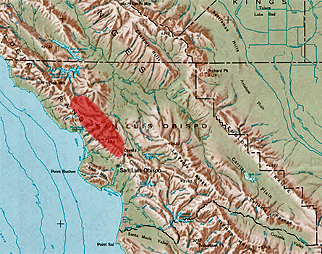|
 |
| Adult 1, San Luis Obispo County |
 |
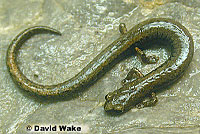 |
| Adult 1, San Luis Obispo County |
Adult 1, San Luis Obispo County
© David Wake |
Adult 1, shown above, was the first live specimen of B. minor found in more than ten years. It was discovered by Tim Burkhardt and Samantha Winegarner in February of 2001. Chemical analysis by the University of California at Berkeley confirmed the species.
|
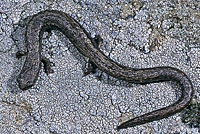 |
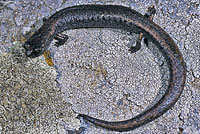 |
|
Adult 2, San Luis Obispo County
Adult 2 was found by Tim Burkhardt in February 2003 in the same location where adult 1 was found.
It is difficult to differentiate B. minor from B. nigriventris by sight. This salamander was identified as B. minor because of the relatively larger size of its limbs and feet when compared to B. nigriventris. This ID was tentatively confirmed in photographs by herpetologist and Batrachoseps expert David Wake, but the species was not confirmed by chemical analysis, which is the best way to identify the species.
|
|
 |
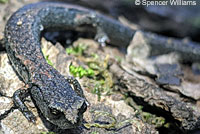 |
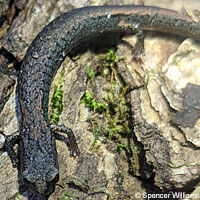 |
Adult, San Luis Obispo County. © Spencer Williams. An expert confirmed the species from these pictures, noting the dorsal texture, which is matte, not glossy, the large head, the relatively short tail, long legs, and large feet with distinct toes, and the orange wash on the thighs.
|
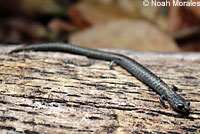 |
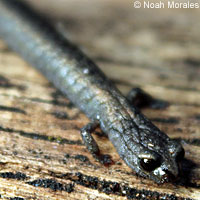 |
 |
Adult, San Luis Obispo County © Noah Morales
This salamander was confirmed genetically as B. minor. |
 |
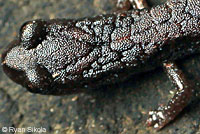 |
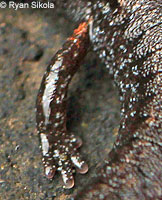 |
| Adult, San Luis Obispo County © Ryan Sikola - with close-up of hind foot on the right. |
 |
 |
 |
Adult, San Luis Obispo County
© Spencer Riffle |
Adult, San Luis Obispo County
© Spencer Riffle |
Adult, San Luis Obispo County
© Spencer Riffle |
 |
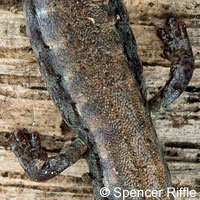 |
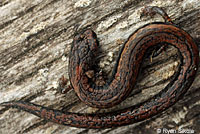 |
Adult, San Luis Obispo County
© Spencer Riffle |
Adult, San Luis Obispo County
© Spencer Riffle |
Adult, San Luis Obispo County
© Ryan Sikola |
 |
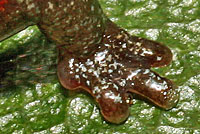 |
|
Adult, San Luis Obispo County
© Ryan Sikola |
Slender Salamanders (genus Batrachoseps) have only 4 toes on their hind feet. All other California salamanders have 5 toes on their hind feet. |
|
| |
|
|
| Juveniles |
 |
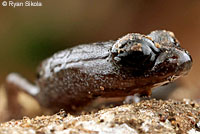 |
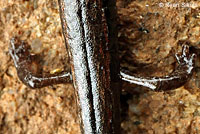 |
| Tiny juvenile - 3.2 cm (1.3 in.) long, San Luis Obispo County © Ryan Sikola |
| |
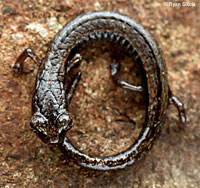 |
|
| |
Tiny juvenile - 3.2 cm (1.3 in.) long, San Luis Obispo County © Ryan Sikola |
|
| |
|
|
| Comparisons With Sympatric Batrachoseps nigriventris |
Coexists with B. nigriventris - Black-bellied Slender Salamander, in the Coast Range.
B. minor is distinguished by its more robust body, broader head and longer and larger limbs with more conspicuous toes than B. nigriventris.
|
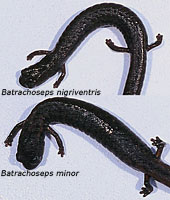 |
 |
 |
Top: B. nigriventris
Bottom: B. minor
B. minor occurs entirely within the range of B.nigriventris. It is shown here with a small adult specimen of B. nigriventris that was found outside of the range of
B. minor. B
minor has distinctly larger hands and feet. |
Top: B. nigriventris
Bottom: B. minor
This comparison shows the different head and face shapes of adults of the two species. B. minor has a distinctly broader head with more prominent eyes. © Ryan Sikola |
Top: B. nigriventris
Bottom: B. minor
This comparison shows the different head and face shapes of yearling juveniles of the two species.
© Ryan Sikola |
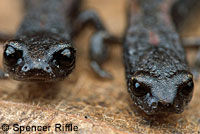 |
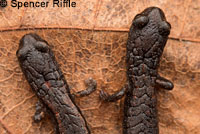 |
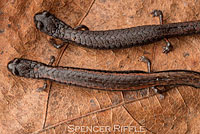 |
Left: B. minor
Right: B. nigriventris
|
Left: B. nigriventris
Right: B. minor
|
Top: B. minor
Bottom: B. nigriventris
|
Comparison of two salamanders found under same log in San Luis Obispo County
© Spencer Riffle |
| |
|
|
| Habitat |
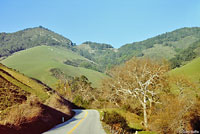 |
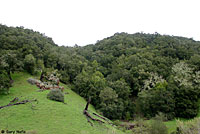 |
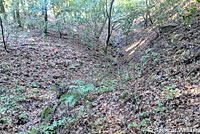 |
| Habitat, San Luis Obispo County |
Habitat, San Luis Obispo County |
Habitat, San Luis Obispo County
© Spencer Williams |
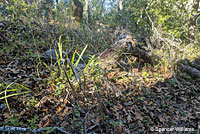 |
 |
|
Habitat, San Luis Obispo County
© Spencer Williams |
Habitat, San Luis Obispo County
© Spencer Williams |
|
|
|
|
| Description |
| |
| Size |
Adults are 1 - 2 3/10 inches long (2.5 - 5.8 cm) from snout to vent.
|
| Appearance |
A small, slim salamander, the smallest of the Slender Salamanders (Batrachoseps), with 17-18 costal grooves, a short body, fairly long legs, and a broad head with a distinct neck. The eyes are slightly protuberant.
Small size, short limbs, a long slender body with a narrow head and a long tail, and conspicuous costal and caudal grooves give this species the worm-like appearance typical of most Slender Salamanders.
There are 5-8 costal folds between adpressed limbs.
There are four toes on the front and hind feet, which is typical of Slender Salamanders. (Other salamanders found in California have five toes on the hind feet.)
|
| Color and Pattern |
Color is blackish brown, sometimes with a tan dorsal stripe, with pinkish or apricot highlights, most noticeable on the tail.
Preserved in alcohol: "The venter is always lighter than the dorsum and is generally gray to gray brown."
In life: "Dense tiny white speckles covered all ventral surfaces..."
(Jockusch, Yanev, and Wake, 2001).
|
| Comparison with Sympatric Slender Salamanders |
Coexists with the Black-bellied Slender Salamander, B. nigriventris, but the two species are very similar in appearance and can be difficult to differentiate. B. minor is small, but where the two species cooccur, B. nigriventris also tends to be small (David Wake, pers. comm.) so one cannot tell them apart by body size alone. It's best to compare the relative size of certain features: B. minor is distinguished by its more robust body, with a broader head, longer and larger limbs, and more conspicuous toes than B. nigriventris.
|
| Life History and Behavior |
A member of family Plethodontidae, the Plethodontid or Lungless Salamanders.
Plethodontid salamanders do not breathe through lungs. They conduct respiration through their skin and the tissues lining their mouth. This requires them to live in damp environments on land and to move about on the ground only during times of high humidity. (Plethodontid salamanders native to California do not inhabit streams or bodies of water but they are capable of surviving for a short time if they fall into water.)
Plethodontid salamanders are also distinguished by their nasolabial grooves, which are vertical slits between the nostrils and upper lip that are lined with glands associated with chemoreception.
All Plethodontid Salamanders native to California lay eggs in moist places on land.
The young develop in the egg and hatch directly into a tiny terrestrial salamander with the same body form as an adult.
(They do not hatch in the water and begin their lives as tiny swimming larvae breathing through gills like some other types of salamanders.)
|
| Activity |
Active on rainy or wet nights when temperatures are moderate, fall through spring.
Retreats underground when the soil dries or when air temperature drops to near freezing.
Found under rocks, logs, bark, and other debris.
|
| Defense |
Slender salamanders use several defense tactics, including:
- Coiling and remaining still, relying on cryptic coloring to avoid detection.
- Uncoiling quickly and springing away repeatedly bouncing over the ground, then remaining still again to avoid detection.
- Detaching the tail, which wriggles on the ground to distract a predator from the salamander long enough for it to escape.
(After its tail is detached or severed, the salamander will grow a new tail.) |
| Diet and Feeding |
Most likely eats a variety of small invertebrates.
Feeding behavior is not well known, but other Batrachoseps species are sit-and-wait predators that use a projectile tongue to catch prey. |
| Reproduction |
Little is known about the breeding behavior and egg-laying habits of this species.
Reproduction is terrestrial.
|
| Eggs |
| Other female Slender Salamanders lay eggs in moist places underground. |
| Young |
Young develop completely in the egg and hatch fully formed.
|
| Habitat |
Inhabits moist locations in forests of mixed oak, tanbark oak, sycamore and laurel above 1,300 ft. (400 m).
|
| Geographical Range |
Endemic to California. Found only in a small area in the southern Santa Lucia Mountains of San Luis Obispo county.
|
| Notes on Taxonomy |
Prior to its description in 2001, B. minor was recognized as B. pacificus which has been split into ten species as the result of molecular studies.
---------------------------------------------------------------------------------------------------------------------------------------------------------------------
"B. minor is now genuinely rare. We (Arden Brame and I) once found 25 salamanders in an area near York Mountain Winery. They could be sorted into two piles of 10 and 15. The B. minor were small but robust, with distinctly larger hands and feet in individuals of the same length, and these also had a somewhat broader head and a "neck", although the latter feature is subtle. When examined osteologically the two also differed in one important character, presence or absence of a tibial spur. This is what convinced me that there were two species. It took many years to finally get the genetic information that demonstrated that the two rather similar species are distinct and not even close relatives."
(David B. Wake, public internet forum correspondence.)
---------------------------------------------------------------------------------------------------------------------------------------------------------------------
Here's a Diagram of the Batrachoseps Complex showing the relationships between species.
---------------------------------------------------------------------------------------------------------------------------------------------------------------------
Alternate and Previous Names (Synonyms)
Batrachoseps minor - Lesser Slender Salamander (Jockusch, Yanev, Wake 2001, Stebbins 2003, 2012)
Batrachoseps pacificus - Pacific Slender Salamander (Stebbins 1985)
Batrachoseps attenuatus - California Slender Salamander (Stebbins 1954, 1966)
Batrachoseps attenuatus attenuatus - Worm-salamander (Bishop 1943)
Batrachoseps attenuatus - Slender Salamander (Storer 1925)
Batrachoseps nigriventris (Cope 1869)
Batrachoseps attenuatus (Cooper 1868)
Batrachoseps attenuata (Baird 1850)
Salamandrina attenuata (Eschscholtz 1833)
|
| Conservation Issues (Conservation Status) |
| Previously more common, B. minor is now difficult to find, and is greatly outnumbered by B. nigriventris with which it co-exists. Similarities in appearance with B. nigriventris make it difficult to survey for and estimate current numbers of this species. |
|
| Taxonomy |
| Family |
Plethodontidae |
Lungless Salamanders |
Gray, 1850 |
| Genus |
Batrachoseps |
Slender Salamanders |
Bonaparte, 1841 |
Species
|
minor |
Lesser Slender Salamander |
Jockusch, Yanev & Wake, 2001 |
|
Original Description |
Elizabeth L. Jockusch, Kay P. Yanev, and David B. Wake ''Molecular phylogenetic analysis
of slender salamanders, genus Batrachoseps (Amphibia: Plethodontidae), from central coastal
California with descriptions of four new species.'' Herpetological Monographs, #15 2001.
|
|
Meaning of the Scientific Name |
Batrachoseps - Greek - batrachos = amphibian, frog + seps = lizard — describes lizard-like appearance
minor - Latin - minor = smaller, less [referring to the small body size compared to other Batrachoseps species]
to other Batrachoseps species
from Scientific and Common Names of the Reptiles and Amphibians of North America - Explained © Ellin Beltz
|
|
Similar Neighboring Salamanders |
Batrachoseps incognitus
Batrachoseps nigriventris
Batrachoseps gavilanensis
|
|
More Information and References |
California Department of Fish and Wildlife
AmphibiaWeb
Elizabeth L. Jockusch, Kay P. Yanev, and David B. Wake ''Molecular phylogenetic analysis of slender salamanders, genus Batrachoseps (Amphibia: Plethodontidae), from central coastal California with descriptions of four new species.'' Herpetological Monographs, #15 2001.
Robert C. Thomson, Amber N. Wright, and H. Bradley Shaffer.California Amphibian and Reptile Species of Special Concern. University of California Press, 2016. Hansen, Robert W. and Shedd, Jackson D. California Amphibians and Reptiles. (Princeton Field Guides.) Princeton University Press, 2025.
Stebbins, Robert C., and McGinnis, Samuel M. Field Guide to Amphibians and Reptiles of California: Revised Edition (California Natural History Guides) University of California Press, 2012.
Stebbins, Robert C. California Amphibians and Reptiles. The University of California Press, 1972.
Flaxington, William C. Amphibians and Reptiles of California: Field Observations, Distribution, and Natural History. Fieldnotes Press, Anaheim, California, 2021.
Nicholson, K. E. (ed.). 2025. Scientific and Standard English Names of Amphibians and Reptiles of North America North of Mexico, with Comments Regarding Confidence in Our Understanding. Ninth Edition. Society for the Study of Amphibians and Reptiles. [SSAR] 87pp.
Samuel M. McGinnis and Robert C. Stebbins. Peterson Field Guide to Western Reptiles & Amphibians. 4th Edition. Houghton Mifflin Harcourt Publishing Company, 2018.
Stebbins, Robert C. A Field Guide to Western Reptiles and Amphibians. 3rd Edition. Houghton Mifflin Company, 2003.
Behler, John L., and F. Wayne King. The Audubon Society Field Guide to North American Reptiles and Amphibians. Alfred A. Knopf, 1992.
Robert Powell, Roger Conant, and Joseph T. Collins. Peterson Field Guide to Reptiles and Amphibians of Eastern and Central North America. Fourth Edition. Houghton Mifflin Harcourt, 2016.
Powell, Robert., Joseph T. Collins, and Errol D. Hooper Jr. A Key to Amphibians and Reptiles of the Continental United States and Canada. The University Press of Kansas, 1998.
American Museum of Natural History - Amphibian Species of the World 6.2
Bartlett, R. D. & Patricia P. Bartlett. Guide and Reference to the Amphibians of Western North America (North of Mexico) and Hawaii. University Press of Florida, 2009.
Bishop, Sherman C. Handbook of Salamanders. Cornell University Press, 1943.
Lannoo, Michael (Editor). Amphibian Declines: The Conservation Status of United States Species. University of California Press, June 2005.
Petranka, James W. Salamanders of the United States and Canada. Smithsonian Institution, 1998.
|
|
|
The following conservation status listings for this animal are taken from the July 2025 State of California Special Animals List and the July 2025 Federally Listed Endangered and Threatened Animals of California list (unless indicated otherwise below.) Both lists are produced by multiple agencies every year, and sometimes more than once per year, so the conservation status listing information found below might not be from the most recent lists, but they don't change a great deal from year to year.. To make sure you are seeing the most recent listings, go to this California Department of Fish and Wildlife web page where you can search for and download both lists:
https://www.wildlife.ca.gov/Data/CNDDB/Plants-and-Animals.
A detailed explanation of the meaning of the status listing symbols can be found at the beginning of the two lists. For quick reference, I have included them on my Special Status Information page.
If no status is listed here, the animal is not included on either list. This most likely indicates that there are no serious conservation concerns for the animal. To find out more about an animal's status you can also go to the NatureServe and IUCN websites to check their rankings.
Check the current California Department of Fish and Wildlife sport fishing regulations to find out if this animal can be legally pursued and handled or collected with possession of a current fishing license. You can also look at the summary of the sport fishing regulations as they apply only to reptiles and amphibians that has been made for this website.
|
| Organization |
Status Listing |
Notes |
| NatureServe Global Ranking |
G1 |
Critically Imperiled. |
| NatureServe State Ranking |
S1 |
Critically imperiled
|
| U.S. Endangered Species Act (ESA) |
None |
|
| California Endangered Species Act (CESA) |
None |
|
| California Department of Fish and Wildlife |
SSC |
Species of Special Concern |
| Bureau of Land Management |
None |
|
| USDA Forest Service |
S |
Sensitive |
| IUCN |
DD |
Data Deficient |
|
|
|
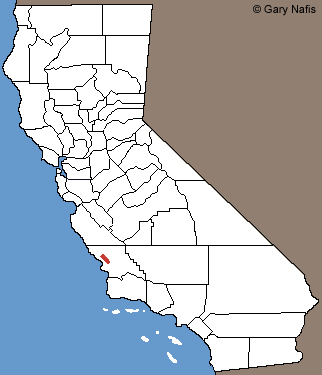 Red: Range in California
Red: Range in California